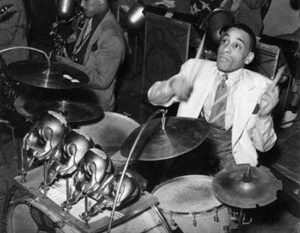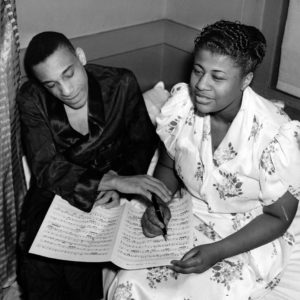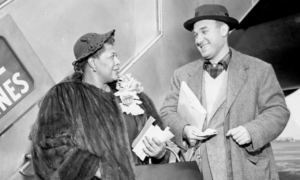Here’s what happened:
On November 21, 1934, the 17 year-old Ella Jane Fitzgerald participated in one of the first “Amateur Nights” held at the Apollo Theater, the famed music hall located at 253 West 125th Street in Manhattan’s Harlem neighborhood. Fitzgerald and a friend named Charles Gulliver had created a dance routine that they performed in local clubs, and it was as a dancer that she intended to perform at the Apollo.
Young Ella was preceded on stage by a local dance duo called the Edwards Sisters. The sisters must have been good, because the excessively shy and most definitely gawky Ella Fitzgerald was intimidated down to her cockles (don’t ask) and decided on the spot not to dance but instead, to sing a couple of songs.
From such serendipitous events do the greatest of things often develop.

Fitzgerald’s decision to sing instead of dance didn’t come completely out of the blue; she’s been singing on the streets of Harlem for roughly a year for the loose coin or two. She sang in the style of her hero, Connee Boswell (1907-1976), later saying that:
“My mother brought home one of her records, and I fell in love with it. I tried so hard to sound just like her.”
Ella sang the songs Judy (by Sammy Lerner and Hoagy Carmichael) and The Object of My Affection (by Jimmie Grier, Pinky Tomlin and Coy Poe). Lo and behold, she won first prize. Part of that first prize was an opportunity to perform at the Apollo for a week. But on this, the management of the Apollo reneged; according to Fitzgerald’s biographer Stuart Nicholson, it was because of her “disheveled appearance.”
(“Disheveled appearance” my tuchas; let’s translate that: it was because Ella was chubby, rather unattractive, and being an orphan only recently released from the New York Training School for Girls – a state reform school in Hudson, New York – she was likely underdressed. Fitzgerald knew that she didn’t fit the physical image of a chanteuse:
“I know I’m no glamor girl, and it’s not easy for me to get up in front of a crowd of people. It used to bother me a lot, but now I’ve got it figured out that God gave me this talent to use, so I just stand there and sing.”)

Sing is what she did, and it was Fitzgerald’s victory at the Apollo brought her to the attention of the bandleader and drummer Chick Webb (1905-1939). Webb liked what he heard, but he didn’t like what he saw and, according to The New York Times film and music critic Stephen Holden, Webb “was reluctant to sign her to a contract because she was gawky and unkempt”, though as the band leader Mario Bauza later remembered, she was “a diamond in the rough.”
Chick made Ella an offer she couldn’t refuse: come with the band to New Haven, Connecticut, and perform on a gig at Yale University. Webb told her that if the students liked her he’d hire her.
Writes The New York Times music critic John Rockwell,
“She did, and he did, and the legend of ‘Ella’, America’s incontestably greatest woman jazz-pop singer, was born.”
Ella Jane Fitzgerald was born on April 25, 1917, in Newport News, Virginia, the daughter of William Fitzgerald and Temperance Henry. Her parents were unmarried and split up when Ella was about 2 years-old. With her new partner, a Portuguese immigrant named Joseph Da Silva, “Tempe” Henry moved to Yonkers, New York, just north of New York City.
Disaster struck in 1932 when Ella was 15, when her mother died from injuries sustained in a car accident. Predictably, her life fell apart; she stopped attending school and worked for a time as a lookout for a bordello and ran numbers for the local Mafiosi. She was arrested and placed in the Colored Orphan Asylum in the Bronx, and from there shipped off to New York Training School for Girls. She was released in 1933 at the age of 16, roughly a year before her appearance at the Apollo’s Amateur Night.
Chick Webb’s was the resident band at Harlem Savoy Ballroom, and it was from that renowned venue that Ella Fitzgerald’s fame grew. In 1938 she was vaulted into the national spotlight when a song she co-authored and recorded – A-tisket, A-tasket – hit the top of the charts and became one of the best selling records of the decade.

Through the 1940s and into the 1950s, Fitzgerald was known primarily as a jazz singer, someone whose vocal improvisation – or “scat singing” (what a terrible term, no?) – made her the equal of any horn player. But she was still a black performer living and working in a deeply racist environment, an environment that denied her opportunities that, had she been white, would have been hers for the taking.

That all began to change when she met Norman Granz (1918-2001). Born in Los Angeles, the son of Jewish immigrants, Granz has rightly been called “the most successful impresario in the history of jazz.” Granz created a phenomenally successful travelling jazz roadshow called “Jazz at the Philharmonic” (JATP) that featured many of the greatest jazz artists of the 1940s and 50s. He founded five jazz record labels, including Verve and Pablo. He desegregated his audiences and insisted on equal pay, dressing rooms, transportation, and accommodations for white and black musicians. (Oscar Peterson recalled how “Granz once insisted that white cabdrivers take his black artists as customers while a policeman pointed a loaded pistol at his stomach.”)
In 1949 Ella Fitzgerald made her first appearance with JATP, and thus began her relationship with Norman Granz.… continue reading and see Dr. Bob’s Prescribed recordings, only on Patreon.
